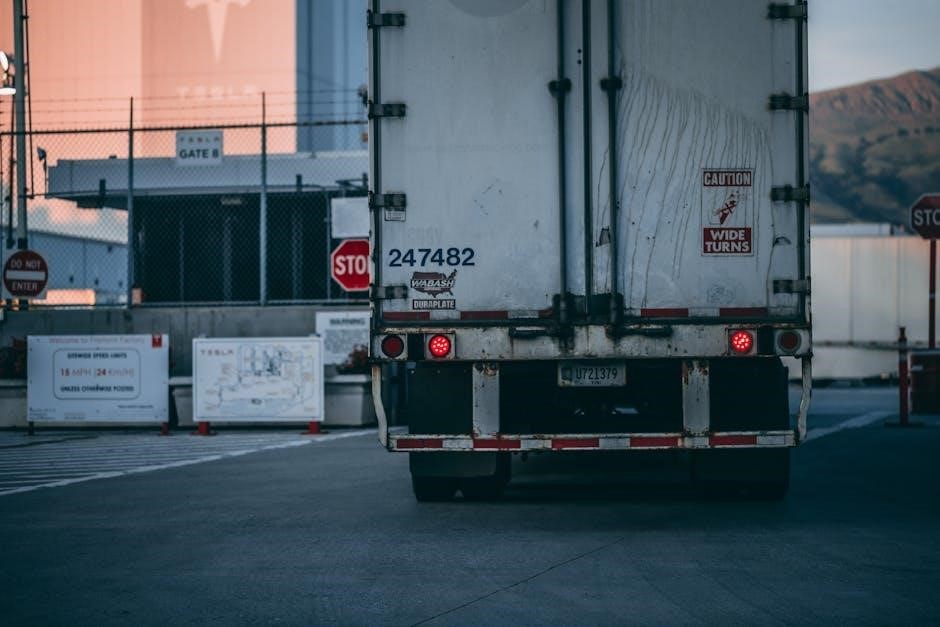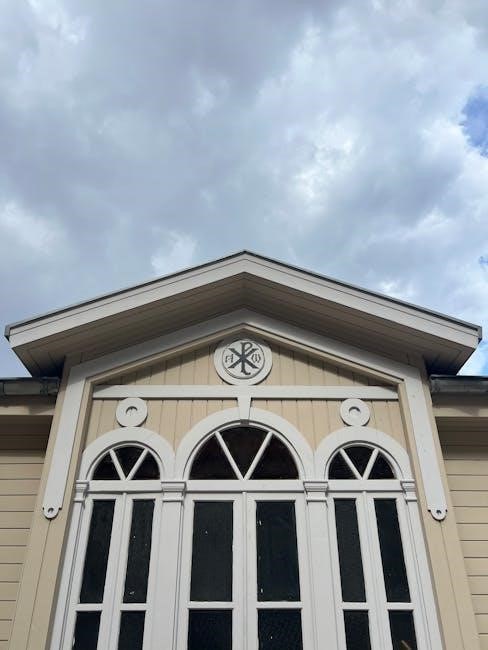Trailer guides are essential tools for safe and efficient towing, assisting in loading, unloading, and aligning trailers. They enhance stability, reduce damage risks, and simplify the towing process.
What Are Trailer Guides?
Trailer guides are devices or systems designed to assist in aligning, loading, and securing trailers. They help users position trailers accurately, reducing damage and hassle during towing. These guides can be manual or automated, offering stability and control. They are commonly used for boats, camping, and enclosed trailers, ensuring safe and efficient towing experiences. Trailer guides also minimize the risk of misalignment and improve overall towing stability, making them indispensable for both novice and experienced users.
Importance of Trailer Guides for Safe Towing
Trailer guides are crucial for ensuring safe and hassle-free towing experiences. They enhance stability by keeping the trailer properly aligned, reducing the risk of swaying or accidents. Guides also protect the trailer and vehicle from damage during loading and unloading. By improving control and visibility, they make towing easier, especially for novices. Additionally, trailer guides minimize wear and tear on equipment, ensuring long-term durability. Their role in preventing misalignment and promoting smooth towing makes them indispensable for both recreational and professional use.
Types of Trailer Guides Available
Trailer guides come in various forms to suit different needs. Roller guides are ideal for boat trailers, providing smooth loading and unloading. Adjustable post guides offer flexibility for enclosed trailers, while alignment guides enhance towing precision. DIY solutions, such as PVC pipe systems, are cost-effective and customizable. Each type ensures safe and efficient towing, catering to specific trailer types and user preferences. Choosing the right guide depends on the trailer’s size, weight, and intended use, ensuring optimal performance and durability.

Camping Trailer Guides
Camping trailer guides enhance your outdoor adventure by providing stability and ease of use. They help maneuver and secure your trailer, making setup hassle-free and ensuring a safe camping experience.
How to Choose the Right Camping Trailer Guide
Selecting the right camping trailer guide involves considering your trailer’s size, weight, and towing frequency. Look for durability, ease of use, and compatibility with your vehicle. Opt for guides made from sturdy materials like metal or high-quality PVC. Ensure the guide system includes features like alignment assistance and stability enhancements. Additionally, consider whether you need manual or automated systems. Always check reviews and compatibility before purchasing to ensure a seamless camping experience.
Best Practices for Hitching a Camping Trailer

When hitching a camping trailer, ensure proper alignment between the trailer and vehicle. Use a spotter for visibility and guide the trailer slowly. Secure the coupler to the hitch ball tightly and double-check the latch. Tighten the hitch pin and ensure the safety chains are properly attached. Connect the brake controller and lighting system, then test the brakes and lights. Always chock the wheels and stabilize the trailer before disconnecting. Regularly inspect the hitch and coupler for wear and tear to ensure safe towing.
DIY Camping Trailer Guide Solutions
Creating DIY camping trailer guides can be cost-effective and easy. Use materials like PVC pipe or metal rods to craft guide posts. Mount them to the trailer frame for stability. Ensure they align with your vehicle’s hitch for proper guidance. Add reflective tape for better visibility. Regularly test and adjust the guides for accuracy. This homemade solution can enhance towing efficiency and reduce alignment issues, making your camping trips more enjoyable and stress-free.

Boat Trailer Guides
Boat trailer guides simplify loading and unloading, ensuring proper alignment. They reduce effort, especially when towing alone. DIY solutions, like PVC pipe setups, offer cost-effective alternatives for easy installation.
Boat Trailer Loading and Unloading Tips
Properly align your boat with the trailer using guide posts or rollers to ensure smooth loading. Center the boat on the trailer for balanced weight distribution. When unloading, slowly submerge the trailer into the water until the boat floats freely. Use a winch to secure the boat during loading and unloading. Always maintain control of the boat’s movement to prevent damage. Securing the boat with straps after loading ensures safety during transit.
How to Install Boat Trailer Guide Posts
Installing boat trailer guide posts involves measuring and positioning them evenly on the trailer frame. Secure them using u-bolts or clamps for stability. Ensure the posts are adjustable to accommodate different boat sizes. Align the guides with the boat’s centerline for proper loading. Test the setup by guiding the boat onto the trailer to confirm alignment. Regularly inspect and tighten the posts to maintain durability and safety during towing and launching.
Maintenance Tips for Boat Trailer Guides

Regularly inspect boat trailer guides for damage or wear. Lubricate moving parts to ensure smooth operation and prevent rust. Clean guides after each use to remove dirt and debris. Check for loose bolts and tighten them as needed. Apply rust-inhibiting coatings to metal components. Store guides in a dry place during off-season to prevent corrosion. Inspect rollers and replace them if worn. Proper maintenance ensures longevity and reliable performance when loading and unloading your boat.

Enclosed Trailer Guides
Enclosed trailer guides provide structure and support for securing cargo, ensuring safe transport. They offer cost-effective solutions for organizing and protecting items during transit, enhancing efficiency.
What Makes a Good Enclosed Trailer Guide
A good enclosed trailer guide should be durable, adjustable, and easy to install. It must securely hold cargo in place, preventing shifts during transit. Sturdy materials like metal or heavy-duty PVC ensure longevity. Features such as padding or rollers can protect delicate items from damage; Customization options, like adjustable straps or brackets, allow for versatility. A reliable guide system enhances safety and efficiency, making it a worthwhile investment for frequent haulers. Quality and practicality are key to its effectiveness.
How to Secure Cargo with Trailer Guides
Securing cargo with trailer guides involves proper alignment and tight fastening. Use straps or ropes to tie down items, ensuring they won’t shift during transit. Winches can help tighten loads evenly. Padding or protective covers can prevent damage. Regularly inspect guides and straps for wear. Properly balanced and secured cargo reduces risks of accidents and ensures a smooth towing experience. Always follow manufacturer guidelines for optimal safety and efficiency.
Top Brands for Enclosed Trailer Guides
Leading brands like Extreme Max, SeaSense, and Reese excel in producing high-quality enclosed trailer guides. These brands offer durable, easy-to-install solutions designed for secure cargo handling. Their products feature innovative designs, such as adjustable rollers and heavy-duty materials, ensuring long-lasting performance. Whether for boats, camping, or heavy-duty hauling, these brands provide reliable options to enhance towing safety and efficiency. Investing in trusted brands ensures superior functionality and peace of mind during transit.

Trailer Winches and Guide Systems
Trailer winches and guide systems simplify loading and unloading, ensuring secure cargo handling. They enhance towing efficiency, reduce alignment issues, and minimize damage risks during transit.
How Trailer Winches Enhance Loading and Unloading
Trailer winches provide a mechanical advantage, simplifying the loading and unloading process. They reduce physical strain, ensuring cargo is securely fastened and centered. This minimizes the risk of accidents and damage, especially when handling heavy or unwieldy items. Winches also enable precise control, making it easier to align and position loads correctly. Whether for boats, camping gear, or equipment, trailer winches enhance efficiency and safety, ensuring a hassle-free towing experience.
Choosing the Right Winch for Your Trailer
Selecting the right winch for your trailer involves considering the weight capacity, power source, and durability. Electric winches offer convenience, while manual ones are cost-effective. Ensure the winch matches your trailer’s load rating and type, whether for boats, camping gear, or equipment. Durable materials and reliable braking systems are crucial for safe operation. By choosing the correct winch, you ensure secure loading, reduce strain, and enhance overall towing efficiency and safety.
Guide Systems for Hassle-Free Towing
Guide systems are designed to streamline the towing process, reducing alignment issues and making loading easier. They help center the trailer during hitching, minimizing adjustments and enhancing safety. These systems are particularly useful in tight spaces, ensuring smooth maneuvering. By providing clear visual cues and physical guidance, they simplify towing for both experienced and novice users. A well-designed guide system enhances overall towing efficiency and reduces the risk of damage to the trailer or vehicle.
Trailer Guide Components
Trailer guide components include guide rails, rollers, and lighting, essential for proper aligning and securing trailers during smooth towing, ensuring safety and stability on the road.

Understanding Trailer Guide Rails and Rollers
Trailer guide rails and rollers are key components that assist in aligning and stabilizing trailers during loading and unloading. Made from durable materials like steel or aluminum, these rails provide a smooth surface for the trailer to glide along, reducing friction and potential damage. Rollers, often attached to the rails, help center the trailer and ensure proper alignment. Regular maintenance of these parts is crucial to ensure they function effectively and provide a hassle-free towing experience.
The Role of Guide Poles in Trailer Alignment
Guide poles play a crucial role in trailer alignment by providing visual and physical cues to help drivers position the trailer accurately. Made from durable materials like PVC or metal, these poles are often adjustable and can be customized to fit specific trailer sizes. They simplify the hitching process, reduce the risk of damage, and enhance safety. Regular inspections ensure they remain secure and functional, making them an indispensable tool for efficient and stress-free towing experiences.
Trailer Lighting and Its Importance
Trailer lighting is vital for safety and visibility, ensuring other drivers can see the trailer’s movements. Proper lighting, including brake lights and turn signals, reduces accident risks and enhances communication on the road. It also helps in complying with legal requirements, as trailers must meet specific lighting standards. Regular inspections of lights are crucial to maintain functionality and avoid potential hazards. Well-maintained trailer lighting contributes to a safer and more efficient towing experience, especially in low-visibility conditions.
Trailer Guide Maintenance and Repair
Regular inspections and timely repairs are crucial for trailer guides to ensure optimal performance and safety. Proper maintenance prevents wear and tear, extending their lifespan and reliability.
Regular Inspection of Trailer Guides
Regular inspection of trailer guides is vital to ensure safe and efficient towing. Check for damage, wear, and proper alignment. Inspect rollers, rails, and mounting hardware for integrity. Lubricate moving parts to prevent rust and friction. Look for signs of corrosion or bending, which can compromise stability. Addressing issues early prevents costly repairs and enhances towing performance. A well-maintained guide system ensures smooth loading, unloading, and alignment, reducing the risk of accidents and extending the lifespan of your trailer.
How to Repair Damaged Trailer Guides
Repairing damaged trailer guides involves assessing the extent of the damage and replacing worn or broken components. Inspect rollers, rails, and mounting hardware for wear. Replace damaged parts with compatible replacements. For minor issues, such as misalignment, adjust the guide system to ensure proper positioning. Use lubricants to reduce friction and prevent rust. For severe damage, consider professional assistance. Regular maintenance and timely repairs ensure optimal performance and safety while towing.

Storage Tips to Preserve Trailer Guides
Proper storage is crucial for maintaining trailer guides. Clean the guides thoroughly to remove dirt and debris. Apply a rust-inhibiting lubricant to moving parts. Store the trailer in a dry, shaded area to protect against moisture and direct sunlight. Cover the guides to prevent dust accumulation. Avoid extreme temperatures and humidity. Regularly inspect stored guides for damage or wear. These steps ensure your trailer guides remain in optimal condition for future use.
DIY Trailer Guide Projects
DIY trailer guide projects offer creative, cost-effective solutions for towing needs. Using materials like PVC pipes or wood, enthusiasts can craft custom guides, enhancing towing efficiency and convenience.
Building Your Own Trailer Guide System
Building your own trailer guide system is a cost-effective and customizable solution. Using materials like PVC pipes or wood, you can create guides tailored to your trailer’s size and needs. This DIY approach saves money and allows for easy installation. Many enthusiasts use U-bolts and rollers for smooth operation. With basic tools and materials, you can craft a durable system that enhances loading and unloading efficiency. Homemade guides are especially useful for boat trailers, ensuring proper alignment and reducing damage risks.
Using PVC Pipe for Homemade Trailer Guides
PVC pipe is a popular choice for homemade trailer guides due to its affordability and ease of use. By cutting and assembling PVC sections, you can create a durable guide system. U-bolts and rollers can be attached to the pipes for smooth operation. This DIY method is lightweight, corrosion-resistant, and easy to install. Many enthusiasts swear by PVC guides for their boat trailers, as they provide excellent alignment and reduce wear on the boat. This cost-effective solution is perfect for those looking to save money without compromising functionality.
Cost-Effective Solutions for Trailer Guides
Exploring budget-friendly options for trailer guides can save money without sacrificing functionality. DIY solutions, such as using PVC pipes and U-bolts, offer an affordable way to create durable guide systems. These materials are lightweight, easy to assemble, and resistant to corrosion. Additionally, repurposing existing components or shopping for second-hand guide posts can significantly reduce costs. These solutions are ideal for those seeking practical and economical ways to enhance their trailer’s efficiency and safety, ensuring a hassle-free towing experience.

Trailer Guide Safety and Best Practices
Always inspect trailer guides before use, ensure proper alignment, and follow towing regulations. Regular maintenance and avoiding common mistakes enhance safety and towing efficiency significantly.
Safety Tips for Towing with Trailer Guides
Always inspect trailer guides before use to ensure they are secure and functioning properly. Maintain proper trailer alignment to prevent swaying and loss of control. Use guide posts or rollers to center the trailer during loading. Ensure cargo is evenly distributed and securely fastened to avoid shifting. Never exceed the trailer’s weight capacity, and always follow local towing regulations. Regularly check tire pressure and brakes for safe towing conditions. Proper use of trailer guides significantly reduces accidents and enhances overall towing safety.
Common Mistakes to Avoid When Using Trailer Guides
One of the most common mistakes is failing to properly align the trailer with the vehicle, leading to difficult maneuvering. Overloading the trailer beyond its capacity can cause instability and damage. Neglecting to secure cargo correctly increases the risk of shifting during transit. Many users also overlook regular maintenance of guide systems, which can result in malfunction. Additionally, ignoring weight distribution guidelines and not checking tire pressure can compromise safety. Avoiding these errors ensures smoother and safer towing experiences.
How to Ensure Proper Trailer Alignment
Proper trailer alignment begins with using guide posts or rollers to center the trailer. Always measure the trailer’s width and adjust guide posts accordingly. Ensure the coupler aligns with the hitch before hitching. When loading, center the boat or cargo evenly. Periodically check alignment during long trips to maintain balance. Proper alignment reduces swaying, improves control, and enhances safety while towing. Regular inspections of guide systems ensure they function correctly, preventing misalignment issues.
Trailer Guide Regulations and Legal Aspects
Trailer towing laws vary by region, requiring adherence to weight, size, and safety standards. Ensure compliance with local regulations to avoid penalties and ensure safe operations.
Understanding Trailer Towing Laws
Trailer towing laws regulate weight, size, and safety standards for trailers on public roads. These laws vary by region and are designed to ensure safe towing practices. Key aspects include maximum weight limits, trailer size restrictions, and mandatory safety equipment like brakes and lighting. Additionally, some areas require special permits for oversized or heavy trailers. It’s crucial to familiarize yourself with local regulations to avoid legal penalties and ensure compliance while towing. Always check regional requirements before embarking on a trip.
Weight and Size Restrictions for Trailers
Weight and size restrictions for trailers are enforced to ensure safe towing and road safety. These limits vary by region and are typically based on the trailer’s type, load capacity, and axle count. Exceeding weight limits can lead to legal penalties, while oversized trailers may require special permits. It’s essential to check local regulations before towing to avoid fines and ensure compliance. Adhering to these restrictions helps prevent accidents and maintains road infrastructure integrity.
Insurance Requirements for Trailer Usage
Insurance is crucial for trailer usage to protect against accidents, theft, and damage. Liability coverage is often mandatory, while comprehensive and collision coverage are optional but recommended. Trailer insurance policies vary by provider, with options tailored to different trailer types, such as camping, boat, or enclosed trailers. It’s essential to review your policy to ensure it covers your specific needs and complies with local regulations. Proper insurance ensures financial security and peace of mind while towing.
Trailer guides are indispensable for safe and efficient towing, offering stability, ease of use, and protection for your trailer and cargo, ensuring a hassle-free experience every time.
Final Thoughts on Trailer Guides
Trailer guides are invaluable for enhancing towing safety and efficiency, offering stability and ease of use. Whether for camping, boating, or cargo transport, they simplify loading and unloading, reducing damage risks. Their versatility and durability make them a must-have for any towing setup, ensuring a secure and hassle-free experience. By investing in quality trailer guides, users can enjoy peace of mind and improved control, making every journey more enjoyable and stress-free.
Future Trends in Trailer Guide Technology
Future trailer guide technology will focus on smart systems, integrating automation and sensors for real-time alignment and stability monitoring. Advanced materials like aluminum and carbon fiber will enhance durability while reducing weight. Innovations such as self-adjusting guides and AI-powered towing assistants are expected to emerge, making towing safer and more efficient. Eco-friendly designs and energy-efficient solutions will also gain prominence, catering to the growing demand for sustainable towing options.
Encouragement to Explore More Trailer Guide Options
Exploring various trailer guide options can significantly enhance your towing experience. With a wide range of styles and innovations available, you can find the perfect fit for your specific needs. Whether you prioritize ease of use, durability, or cost-effectiveness, there’s a trailer guide designed to make towing safer and more efficient. Don’t hesitate to research and compare different models—investing in the right guide can transform your towing adventures and provide peace of mind on the road.






























